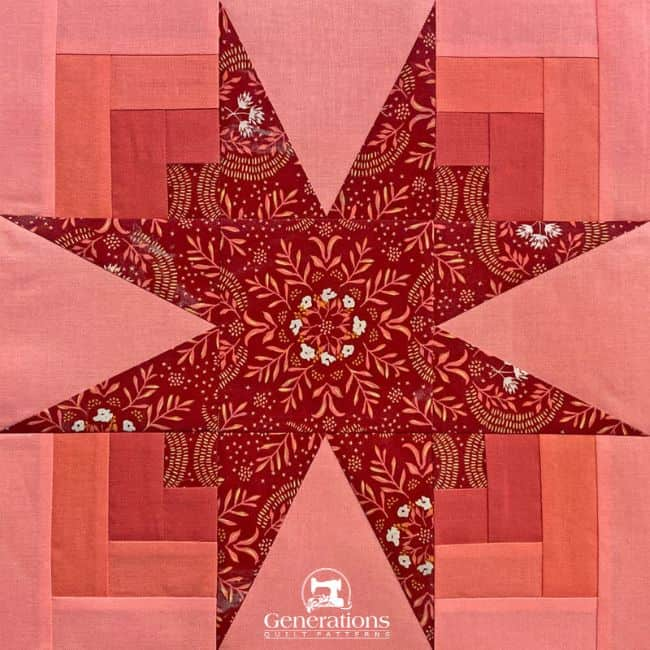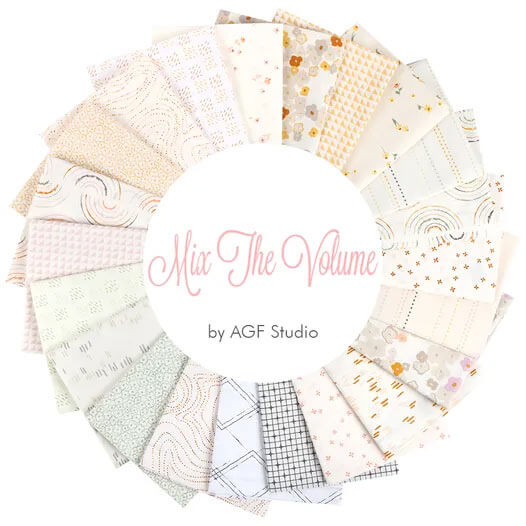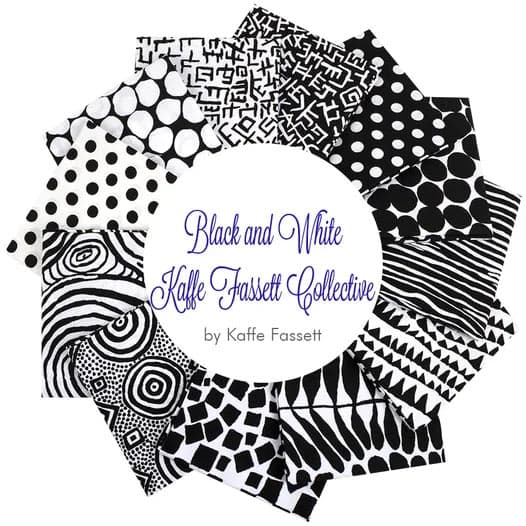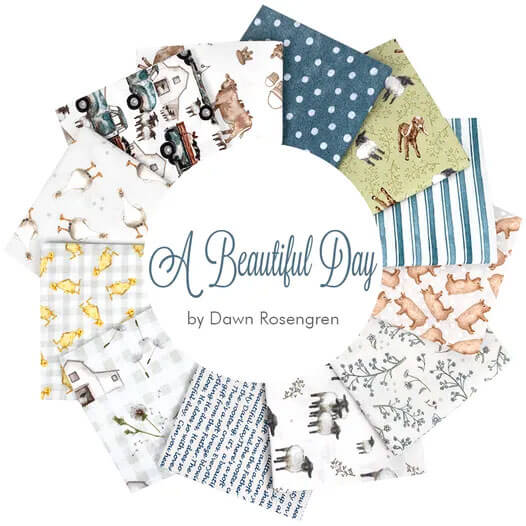- Home
- Free Quilt Block Patterns
- Black Magic Quilt Block
Black Magic Quilt Block Tutorial: 6", 9", 12", and 18" finished blocks
From our Free Quilt Block Patterns Library
This post contains affiliate links, for which I receive compensation.
You'll be captivated by the charm of our bewitching Black Magic quilt block.
Simple Half Log Cabins and Triangle in a Square pointy-points are the magic formula for this mesmerizing 8-point star design. There's no hocus-pocus.
Add a little fussy cutting, and you'll have A-bra-ca-da-bra'd your way to spellbinding quilt block.
As always, step-by-step, beginner-friendly, illustrated instructions are the backbone of the tutorial. There's more free goodies available to you to download to help you. They are:
- Quilting not on your to-do list today? Pin or bookmark this for later.
Ready? It's time to cut up and sew!
General Instructions
Several abbreviations are used on this page. They are:
- SA - seam allowance
- RST - right sides together
- TiaS - triangle in a square
- HLC - Half Log Cabin
1/4" SA are used through this tutorial.
Pressing instructions are highlighted in yellow throughout this tutorial to make them easy to spot.
When instructed to press, first press the patches in the closed position just as they came off your sewing machine. This sets the seam, melding the fibers of the threads into the fibers of the fabric.
The SAs pressed toward the:
- Side and Side.R patches for the Triangle in a Square units
- Open for the Half Log Cabins
Download and print paper piecing pattern
To download the pattern, use the most current version of Adobe.
For accurate results, on Adobe's Print Menu page, under 'Page Size and Handling' set 'Custom Scale' to 100%. Then print.
Click here to see what it looks like on the Print Menu page.
Choose your finished block size from the chart below. Print the corresponding number of pages for a total of four TiaS units (3rd column from the left) and one template copy (right column).
Print Paper Piecing Units and Template | |||
|---|---|---|---|
| Black Magic Finished Block Size | # of copies per block | Finished TiaS Unit Size | Center Templates |
| 6" | 1 | 2" | Print 1 |
| 9" | 1 | 3" | Print 1 |
| 12" | 2 | 4" | Print 1 |
| 18" | 4 | 6" | Print 1 |
After printing, use the 1" square graphic on the printed page(s) to double check that your patterns printed at the correct size.

Not sure which paper to use?
Take a look at my review of several of the most popular brands available to us quilters on the market.
You want a super-easy paper to tear away—less stress on the stitches.
The newest quilt fabrics to tickle your fancy...
Click the images below to see the full collection. We share any commercial and/or free patterns that showcase them, too. (For inspiration, of course!)
✂️ Cutting your patches for a Black Magic block
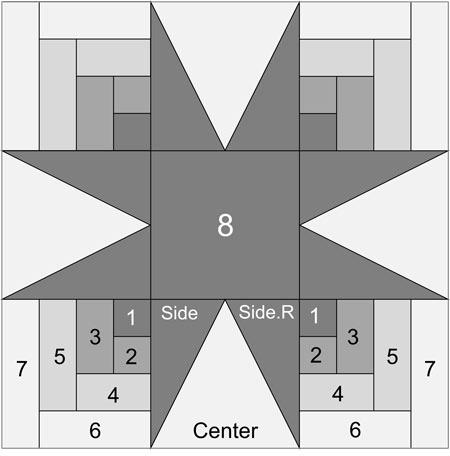
Sample Block Size: 12" finished / 12½" unfinished
Grid: 12x12
Attribution: Elizabeth Stevens, Blue Ribbon Quilts
Design Type: Even 9-patch | Star
Please label all your patches. We use these numbers throughout the tutorial.
To print a copy of the block design and cutting chart to use at your cutting table, click here.
 | Cutting Chart for a~ Paper PLUS Traditional Piecing ~ | |||||
|---|---|---|---|---|---|---|
| Patch | Fabric | Qty | Finished Block Size | |||
| 6'' | 9'' | 12'' | 18'' | |||
| Center | Bac | 4 | 3" x 2¾'' | 4" x 3¾'' | 5" x 4¾'' | 7" x 6¾'' |
| Side, Side.R | Dark | 4 | 2⅞'' x 3¼'' | 3⅜'' x 4¼'' | 3⅞'' x 5¼'' | 4⅞'' x 7¼'' |
| 1 | Dark | 4 | 1'' x 1'' | 1¼'' x 1¼'' | 1½'' x 1½'' | 2'' x 2'' |
| 2 | Medium | 4 | 1'' x 1'' | 1¼'' x 1¼'' | 1½'' x 1½'' | 2'' x 2'' |
| 3 | Medium | 4 | 1'' x 1½'' | 1¼'' x 2'' | 1½'' x 2½'' | 2'' x 3½'' |
| 4 | Med Light | 4 | 1'' x 1½'' | 1¼'' x 2'' | 1½'' x 2½'' | 2'' x 3½'' |
| 5 | Med Light | 4 | 1'' x 2'' | 1¼'' x 2¾'' | 1½'' x 3½'' | 2'' x 5'' |
| 6 | Light | 4 | 1'' x 2'' | 1¼'' x 2¾'' | 1½'' x 3½'' | 2'' 5'' |
| 7 | Light | 4 | 1'' x 2½'' | 1¼'' x 3½'' | 1½'' x 4½'' | 2'' 6½'' |
| 8 | Dark | 1 | 2½'' x 2½'' | 3½'' x 3½'' | 4½'' x 4½'' | 6½'' 6½'' |
| Unfinished Block Size | 6½'' | 9½'' | 12½'' | 18½'' | ||
| Grid Size | ½" | ¾" | 1'' | 1½'' | ||
Subcutting
The patches for the Center and Side/Side.R need to be subcut before we proceed.
At your cutting mat, layer the Side/Side.R rectangles in pairs of right sides together to create the mirror image patches we need.
For our Black Magic quilt block there'll be two pairs RST for a total of 4 rectangles.
Use a pencil and make a tick mark 5/8" in from the top left and lower right edges. (This measurement creates the correct angle to keep the outside edges of the patch on the straight of grain after stitching.)
Align your ruler with these marks at the very top and bottom edges of the rectangles.
Cut.
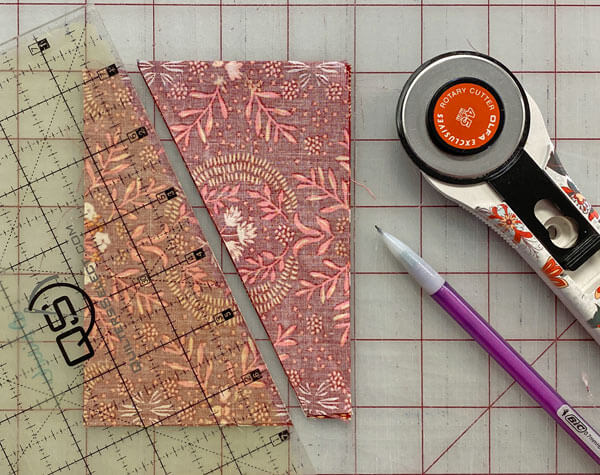
Use the template you printed to cut the Center squares into triangles for our TiaSs.
Layer all four Center squares together. They can be RST or WST, it doesn't matter because the triangle is symmetrical.
The top and bottom edges of the template should be even with the top and bottom edges of the squares. If they are not, turn your squares a quarter turn. Before cutting, they should be even.
Use your rotary cutter and ruler to cut away the excess on both sides.
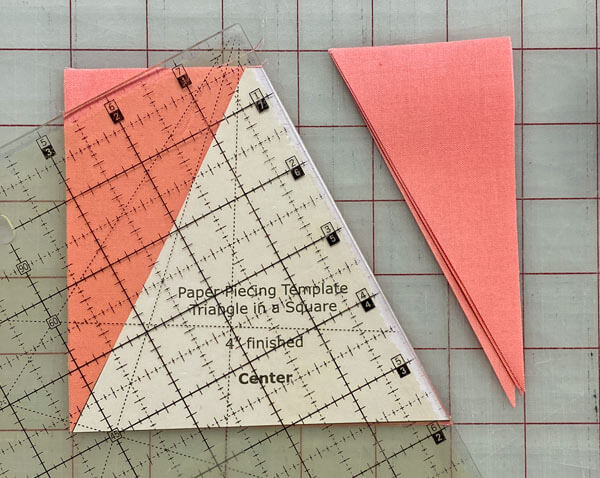 Halfway there, one more cut to make
Halfway there, one more cut to makeThe second cut and these patches are ready.
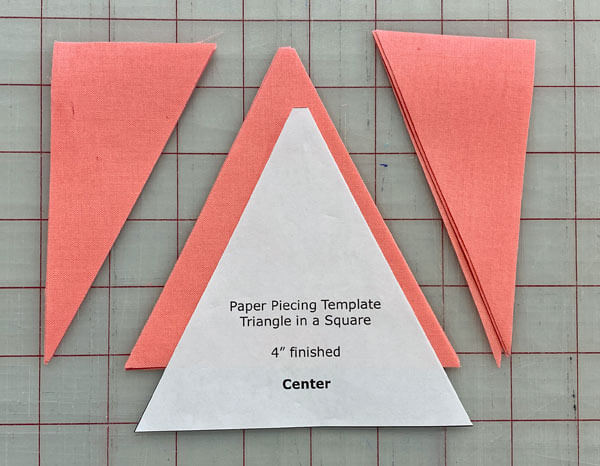
🪡 Assemble the units for a Black Magic block
TiaS Unit (AKA Peaky and Spike)
Make 4
If specialty rulers are more your style, the Tri Recs ruler set can be used to make this unit.
Paper piecing is used to help you avoid having to buy an extra ruler to make a single block.
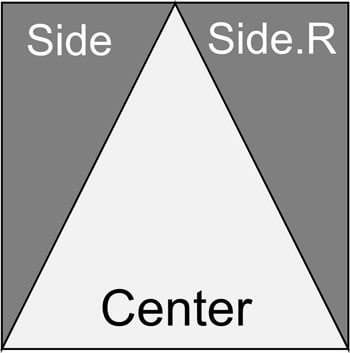
Use the tiniest bit of Elmer's Washable Glue Stick to stick the backside of the Center patch to the unprinted side of the pattern.
Those dashed guidelines help you do this quickly and easily.
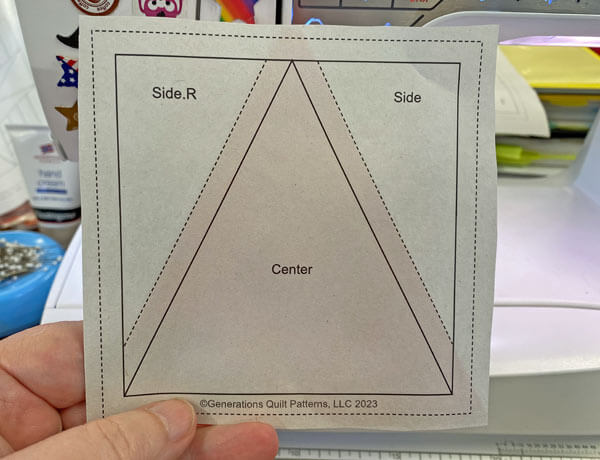
General Sewing Machine Setup for Paperpiecing
- Reduce your stitch length to 16–20 stitches per inch (1.3-1.6 mm). This perforates the paper and stabilizes the seam when you remove the pattern. [Learn more about stitch length here.]
- Reduce your machine's speed or just plain slow down. Sew only as fast as you can stay on the stitching lines.
- Install an open toe appliqué foot (sometimes called an 'embroidery' or 'satin stitch' foot) if you have one (it's easier to see where you're stitching with one installed).
- Use a larger needle (90/14) if you have problems removing the pattern.
- If your machine has a needle stop up, use it. The stitching goes faster when you don't have to lift the presser foot with every seam.
- As you stitch each seam, start and stop a generous 1/4” before and after the solid stitching lines. ALWAYS. Future lines of stitching secure the ends.
After adding each patch, press the unit as it was sewn to set the seam and then open. The SA is automatically pressed towards the last patch added.
Before adding the next patch, take a look to make sure the one you just added covers the space plus seam allowance that it is supposed to.
Steam is optional and usually curls the pattern.
If that bothers you, don't use steam. Sometimes I do. Sometimes I don't.
It truly depends on my mood.
Remember, as you follow this paper piecing tutorial, the printed and the fabric sides of this block are mirror-images of each other.
At last!
Let's sew!
Choose either the Side or Side.R (it doesn't make a difference) and with RST align the long bias edges with that of the Center.
HELPFUL TIP: These Side and Side.R patches are cut so when you position each over the Center, the small point on the short end of the Side matches the point at the bottom of the Center. (red arrow)
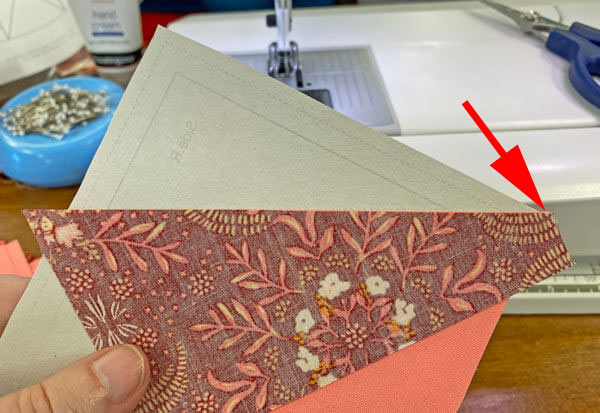
From the printed side, stitch starting past the outside dashed edge of the Tias and ending past the outside dashes. There's no need to make a job out of clipping these thread tails. We'll get them when we trim the TiaS to size.
Press.
Now add the other Side (or Side.R depending on which you chose to sew first) in the same manner.
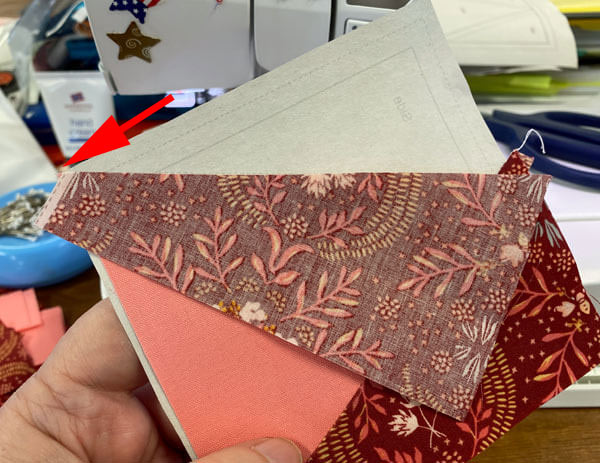 The point on the small end of the Side matches the bottom point on the Center (red arrow)
The point on the small end of the Side matches the bottom point on the Center (red arrow)Sew again as before.
Repeat for a total of four. Then give each a good press.
At your cutting mat, with the paper side up, line up the 1/4" line on your ruler with one side of the solid line square that goes around the block.
Trim away the excess with your rotary cutter. Repeat for each side of each unit.
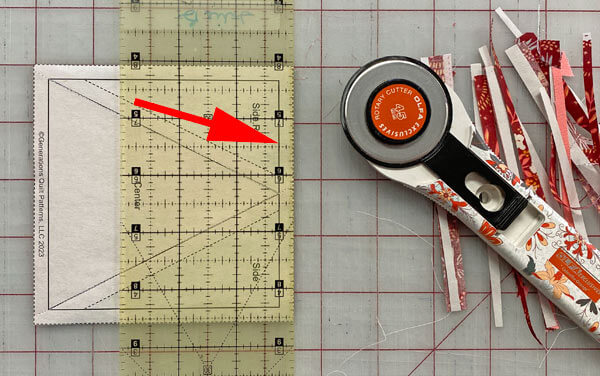
Here's the untrimmed versus the trimmed-to-perfection TiaSs.
Mighty nice, aren't they?!!
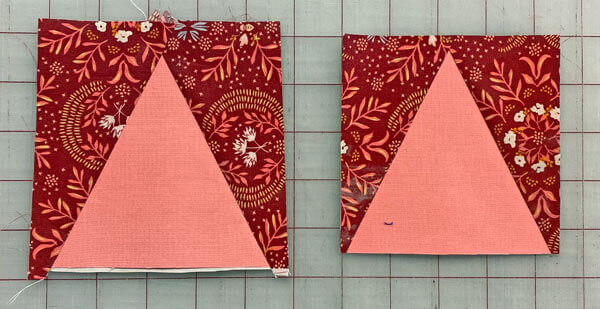
All the outside edges are on the straight of grain. Since we don't need to worry about the edges stretching, remove the paper pattern now.
Our paper piecing is all done.

The paper piecing is complete. From this point forward, return your stitch length to the one you regularly use for piecing and install your favorite 1/4" presser foot.
Half Log Cabins (HLC)
Make 2 each
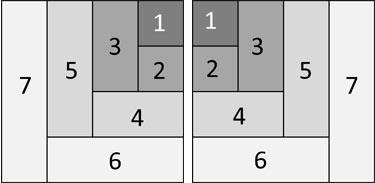 Make two of each version
Make two of each versionI don't usually press a lot of my seams open—nested seams are so much easier, quicker to match.
However, it makes a lot of sense to for this design for two reasons,
- The SAs are pressed away from the Tias whenever possible to avoid lumpy points in the star. Pressing the SAs in the Half Log Cabins in one direction makes REALLY lumpy seams when pressed back on themselves.
- Generally, the SAs are pressed out from the first square in a traditional Log Cabin. In this design, the fabrics get lighter with each round of logs. That means there's an added chance for the darker fabric to shadow through the lighter one once the block is finished.
Pressing all the seams in this unit open, prevents both those situations from happening.
Use this handy chart to check the accuracy of your stitching as you make these units.
After sewing, all units measure... | ||||
|---|---|---|---|---|
| Finished Block Size | Edge-to-edge Measurement | |||
| #3 | #5 | #7 | ||
| 6" | 1½" x 1½" | 2" x 2" | 2½" x 2½" | |
| 9" | 2" x 2" | 2¾" x 2¾" | 3½" x 3½" | |
| 12" | 2½" x 2½" | 3½" x 3½" | 4½" x 4½" | |
| 18" | 3½" x 3½" | 5" x 5" | 6½" x 6½" | |
Remember to press all the seams open after adding each patch.
With RST, stitch each #2 to a #1.
With RST, add a #3 to each #1/#2. Use the image below to add it to the correct side.
 Make 2 of each version
Make 2 of each versionWith RST, add a #4 to #1/#2/#3. Double-check your patches as you stitch. It's too easy to get them sewn to the wrong side.—ask me how I know ;).
It helps to remember that after you've added #3:
- No patch is ever added to the #1 side.
- It is always added to a side with one seam.
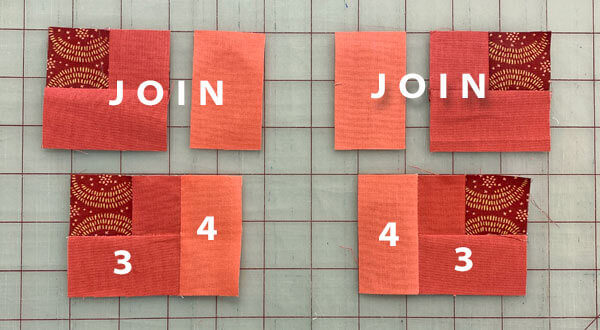
Moving along, add #5 in the same manner. It's starting to look like something now!
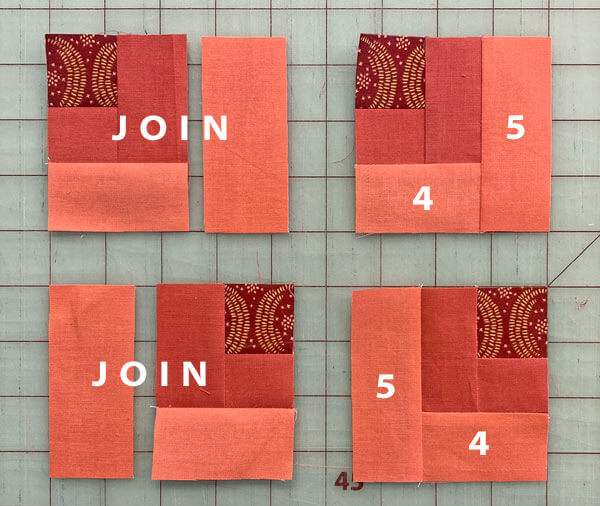
Almost there, add #6.
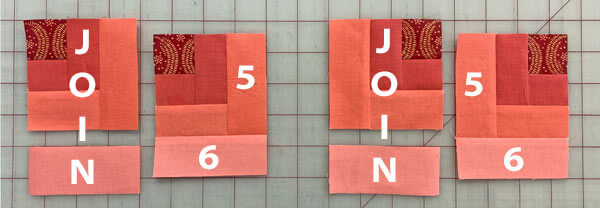
#7 is all that's left to stitch.
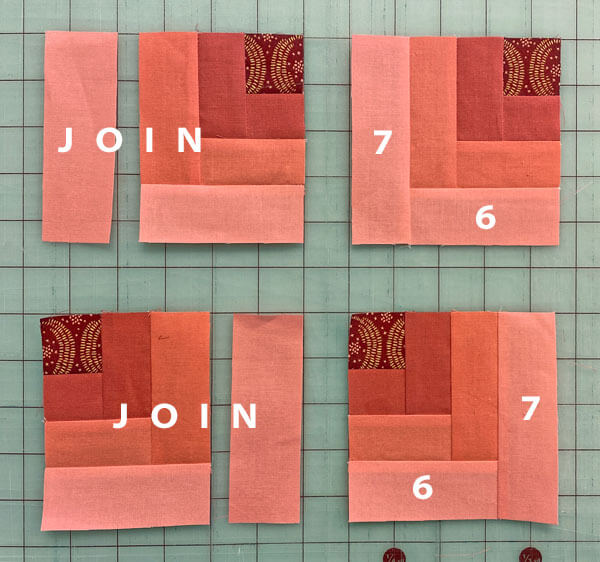
One last double check of the edge-to-edge measurements, one final visit to the iron and you've got four perfect little HLCs.
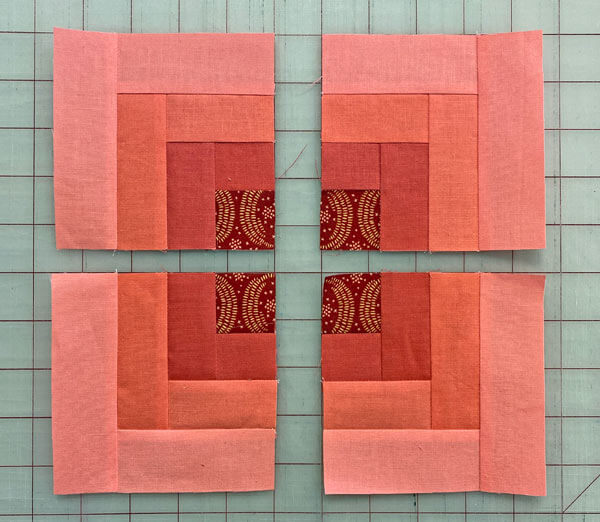 I've laid these out how they'll appear in the block, so you can see how the HLC in each row are a mirror image of each other.
I've laid these out how they'll appear in the block, so you can see how the HLC in each row are a mirror image of each other.And from the backside to see how the SAs lay.
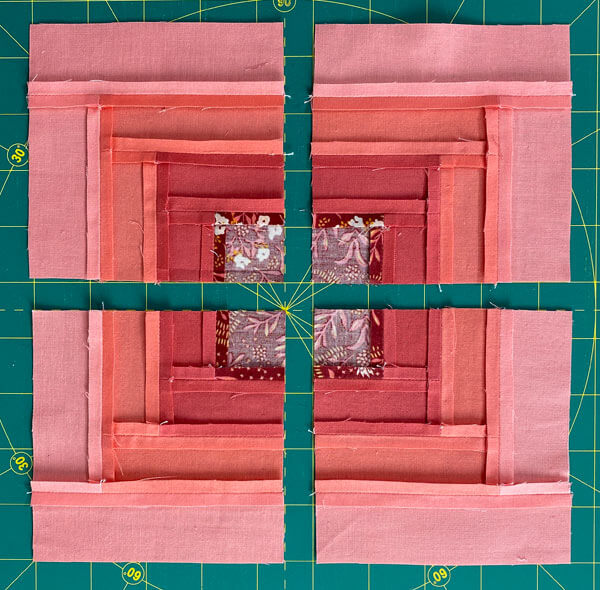
My Bad: Did you notice this is a different set of Half Log Cabins? I forgot to take a picture of them before they were sewn into the block. <hangs head in shame> I remade these just for this photo. :)
🧩 Assemble the Black Magic quilt block
Arrange all your stitched and center cut patch so that the points on your TiaS units are at the outside edge of the block, and the small darkest square of each Half Log Cabins is toward the center.
If these units are accurate, the rest of the piecing is as easy as can be—there's nothing to match except at the four corners of the center patch.
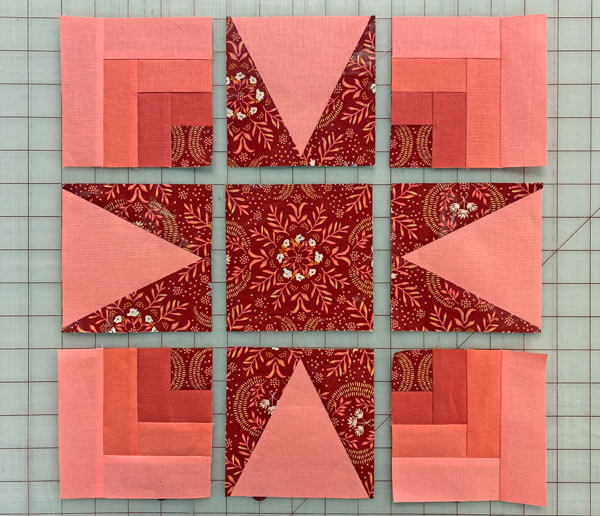
With RST, sew the unit in each row together. Use pins as needed.
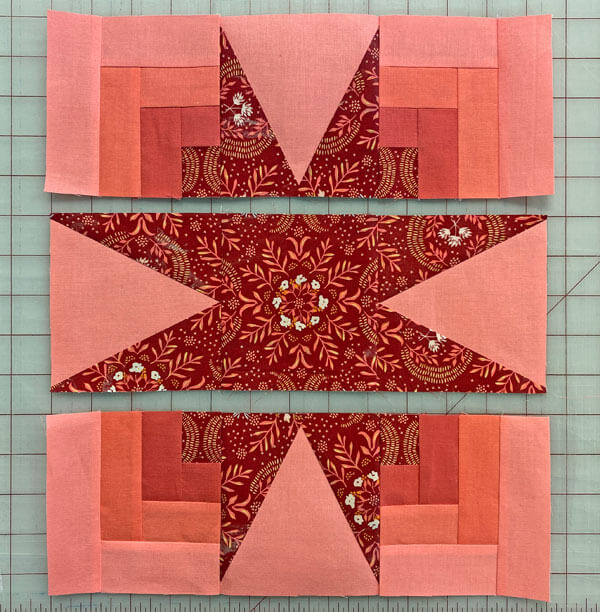
Press the SA toward the Half Log Cabin units.
Now, simply sew the rows together. The seams nest to help you match them with the center square.
There's no Black Magic needed to make this block. Simple paper piecing made everything just right.
This is our finished Black Magic.
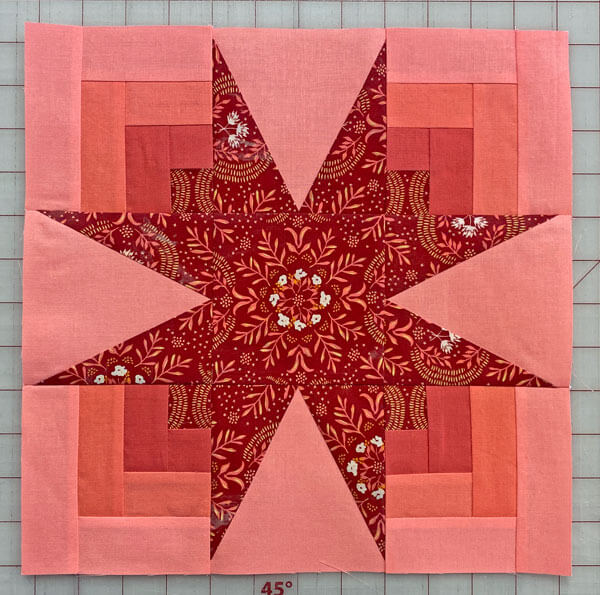
📌 Expelliarmus Pinteresto! 🪄🧵
Don't let our Black Magic disappear in a puff of smoke! 📌 Cast a permanent saving spell by pinning this tutorial to your quilting board - one click captures all the enchantment for your future magical making! 👉 🔗
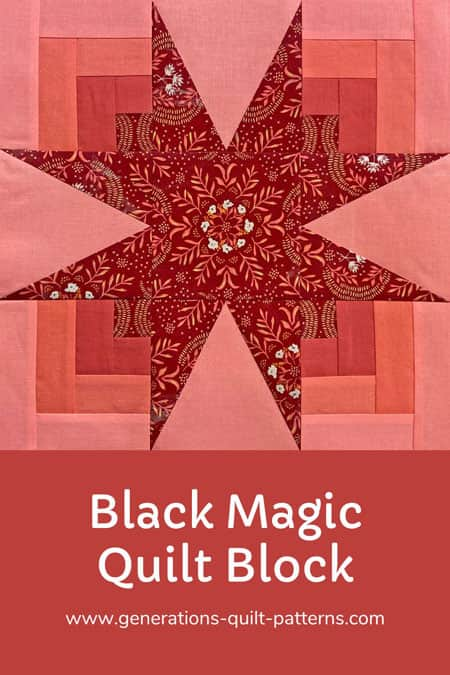
🔭 Looking for something truly stellar?
You've finished your star quilt block, and you're ready for more!
Browse our collection of 70 stellar star quilt block patterns. All have instructions and cutting charts in multiple sizes. If templates or paper piecing is used in the tutorial, there's a free download for you of those materials.
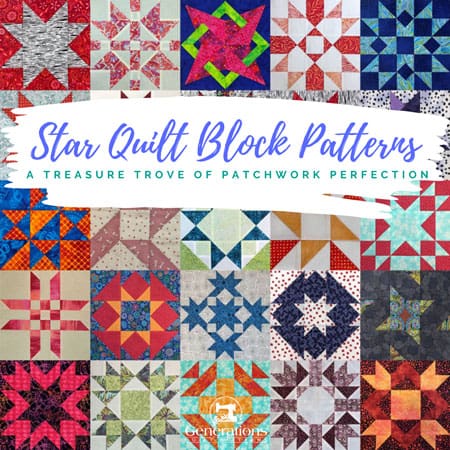
Eeny. Meenie. Miney. Moe.
Which star quilt block will you sew?
For a star-studded quilting experience, choose from 100+ bedazzling star quilt patterns—for beginners and beyond—click here.
For even MORE blocks to make… 🧩🎨

...visit our Free Quilt Block Pattern Library, with over 260+ blocks to choose from in multiple sizes.
Free downloads are included in all sizes for any blocks require paper piecing patterns or templates.
- Home
- Free Quilt Block Patterns
- Black Magic Quilt Block
